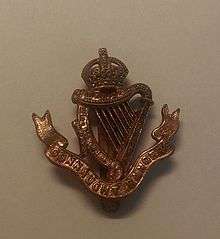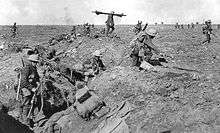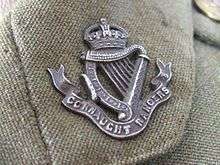Connaught Rangers
| Connaught Rangers (88th Foot & 94th Foot) | |
|---|---|
 Connaught Rangers Cap Badge | |
| Active | 1881–1922 |
| Country |
|
| Branch |
|
| Type | Line infantry |
| Role | Infantry |
| Size |
2 Regular Battalions |
| Garrison/HQ | RHQ – Renmore Barracks, Galway |
| Nickname(s) | The Devil's Own |
| Motto(s) | Quis Separabit (Who will separate us) (Latin) |
| March |
(1) – Saint Patrick's Day |
| Engagements |
Egypt 1801; India; South America; The Peninsula; The Crimea; Indian Mutiny; South Africa 1877–1882; Egypt 1884–86; South Africa 1899–1902; The Great War – France & Flanders; Mesopotamia; Macedonia; Gallipoli; Bulgaria |
The Connaught Rangers ("The Devil's Own") was an Irish line infantry regiment of the British Army formed by the amalgamation of the 88th Regiment of Foot (Connaught Rangers) (which formed the 1st Battalion) and the 94th Regiment of Foot (which formed the 2nd Battalion) in July 1881. Between the time of its formation and Irish independence, it was one of eight Irish regiments raised largely in Ireland, its home depot in Galway.[1] It was disbanded with the Partition of Ireland following establishment of the independent Irish Free State in 1922 when the five regiments that had their traditional recruiting grounds in the counties of the new state were disbanded.[2]
History
Early history
The regiment was formed by the amalgamation of the 88th Regiment of Foot (Connaught Rangers) (which formed the 1st Battalion) and the 94th Regiment of Foot (which formed the 2nd Battalion) in July 1881. The amalgamation of the two regiments into one with the title The Connaught Rangers, was part of the United Kingdom government's reorganization of the British Army under the Childers Reforms, a continuation of the Cardwell Reforms implemented in 1879.[3]

It was one of eight Irish regiments raised largely in Ireland, with its home depot at Renmore Barracks in Galway.[1] The regiment recruited mainly in the province of Connacht. Militarily, the whole of Ireland was administered as a separate command within the United Kingdom with Command Headquarters at Parkgate (Phoenix Park) in Dublin, directly under the War Office in London.[4]
The 88th were based in Bengal, British India, when they were amalgamated into the new regiment.[5] The 94th were based in South Africa at the time of amalgamation; as the 2nd Battalion, it returned to Ireland the following year and sent a small detachment on the Nile Expedition in 1884 as Camel Mounted Infantry.[5] The 2nd Battalion deployed to the Sudan in 1896 for the Dongola Expeditionary Force under the command of Lord Kitchener as part of the reconquest of the Sudan before moving to India in 1897.[5]
Second Boer War
The 1st Battalion deployed to South Africa as part of 5th (Irish) Brigade, commanded by Major-General Fitzroy Hart, and saw action at the Battle of Colenso in December 1899, part of the attempt to relieve the town of Ladysmith, besieged by Boer forces. The Brigade suffered heavily during their participation in the battle, the Boers inflicting heavy casualties: the regiment had 24 men killed and 105 officers and men wounded.[6] The Rangers fought at Spion Kop in January 1900 and the Tugela Heights in February 1900 during further attempts by General Sir Redvers Buller to relieve the besieged town of Ladysmith. In late February the siege of Ladysmith finally came to an end after it was relieved by British forces.[7] The 1st Battalion returned to India in 1903.[5]
First World War




Regular Army
The 1st Battalion, which was commanded by Lieutenant-Colonel Hurdis Ravenshaw and had been stationed in Ferozepore, India, landed as part of the 7th (Ferozepore) Brigade in the 3rd (Lahore) Division at Marseille in September 1914 for service on the Western Front.[8]
The 2nd Battalion landed at Boulogne-sur-Mer as part of the 5th Brigade in the 2nd Division with the British Expeditionary Force in August 1914 for service on the Western Front.[8] Its marching song It's a Long Way to Tipperary became famous.[5] By October, the battalion was involved in the fighting around Ypres. On one occasion Private Grogan rushed seven Germans who had occupied a section of trench. He killed all of them. It cost him a cut forehead and four teeth.[9]
The 3rd (Reserve) Battalion was based in Galway upon the declaration of war and would remain in Ireland until November 1917 when it moved to England.[8] The 4th (Extra Reserve) Battalion had been based in Boyle in August and would remain there until November 1917 when it relocated to Scotland: it was absorbed into the 3rd Battalion in May 1918.[8]
New Armies
The 5th (Service) Battalion, which was formed in Dublin in August 1914, landed at Anzac Cove in Gallipoli in August 1915 as part of the 29th Brigade in the 10th (Irish) Division but moved to Salonika in September 1915 for service on the Macedonian Front and then transferred to Egypt for service in Palestine in September 1917 before landing at Marseilles in June 1918 for service on the Western Front.[8]
The 6th (Service) Battalion, which was formed in County Cork in September 1914, landed at Le Havre as part of the 47th Brigade in the 16th (Irish) Division in December 1915 for service on the Western Front.[8] In just over a week’s fighting in the Battle of the Somme in September 1916, the 6th Battalion lost 23 officers and 407 other ranks.[10] On 21 March 1918, the same Battalion was "practically annihilated" during the German Spring Offensive breakthrough. In one week the battalion lost "22 officers and 618 other ranks".[11] As a result of these heavy losses, the survivors were transferred into the 2nd Battalion, the Leinster Regiment.[8]
1916 Easter Rising
In April 1916 in what became known as the Easter Rising, Irish Republican revolutionary forces in Ireland launched an armed insurrection against the authority of the Government of the United Kingdom, with the declared aim of establishing an Irish Republic wholly independent in its sovereign governance from the United Kingdom. In response, the Connaught Rangers and other British Army units were deployed to fight against the Irish Volunteers. None of the Connaught Rangers were killed in action but one was wounded.[12]
A 584-man strong column from the 3rd Battalion Connaught Rangers commanded by Lieutenant Colonel A J Digan DSO, marched on Enniscorthy to fight the Volunteers who had taken over the town. However they decided not to fight the rebels who held the town until the Rising ended.[13] In the days after the insurrection began, the Connaught Rangers patrolled the Irish countryside seeking contact with elements of the Irish Volunteers, in the process capturing hundreds of prisoners of war and seizing their weapons stocks.[14] A 250 strong force of Connaught Rangers commanded by Major H M Hutchinson marched on Ferns on 4 May and then on Gorey the next day.[15] A force of 31 Connaught Rangers commanded by Lieutenant L C Badham raided homes in Kinsale on 4 May and again the next day capturing a large number of Volunteers and weapons.[16] The Connaught Rangers Column raided homes in New Ross on 9 May and then Waterford the next day.[16] The Connaught Rangers Column reached Clonmel on 16 May and raided homes in the town capturing a large number of Volunteers and weapons.[15]
Another Column of Connaught Rangers, 422 man strong commanded by Major O F Lloyd raided homes in Bandon from 6 May to 11 May capturing a large number of Volunteers and weapons. The Column proceeded to Clonakilty on 11 May and raided the district capturing a large number of Volunteers and equipment. The Column marched to Skibbereen on 16 May and raided the town and surrounding area capturing a number of Volunteers and weapons. A number of Connaught Rangers who were in Dublin at the time of the Easter Rising volunteered for attachment to other units of the British Army such as the Royal Irish Fusiliers and Royal Dublin Fusiliers to oppose the Rising in the fighting raging around the city.[14] Sergeant John Joseph Barror of the Connaught Rangers killing two Irish Volunteers in the Dublin fighting.[14]
Mutiny in India, 1920
On 28 June 1920, five men from C Company of the 1st Battalion, based at Wellington Barracks, Jalandhar in Punjab, decided to protest against the effects of martial law in Ireland by refusing to obey orders. They were soon joined in their protest by other Rangers (the protesters included at least one Englishman, John Miranda, from Liverpool).[17] The protesters were led by Private James Daly (whose brother William took part in the protest at Jalandhar); the protest spread to the Connaught Ranger company at Solan. The Connaught Ranger company at Jutogh hill-station remained loyal to the British crown. A party of men led by Daly made an attempt to recover their arms, storming the armoury. The loyal British guard successfully defended it, and two of Daly's party, Private Patrick Smythe and Private Peter Sears, were killed in the firefight. Within days, both garrisons were occupied by loyal British troops; Daly and his followers surrendered and were taken prisoner. Eighty-eight mutineers were court-martialed: seventy-seven were sentenced to imprisonment and ten were acquitted.[5] The 21-year-old Daly was shot by a firing squad in Dagshai Prison on 2 November 1920: he was the last member of the British Armed Forces to be executed for mutiny.[5] Private Sears and Private Smyth were buried at Solan, while Daly and Miranda (who later died in prison) were buried at the Dagshai graveyard. Among those who received life in prison were Val Delaney, J.J. Buckley, and Eugene Egan (all from Claremorris), Jack Scanlon from Sligo town and Charlie Kerrigan from Glencar, and Martin Conlon (a half brother to the eight brothers from Sligo town who fought in the First World War, in which four were killed in action).[18]
Disbandment
Due to substantial defence cuts and the establishment of the Irish Free State in 1922, it was agreed that the six former Southern Ireland regiments would be disbanded,[2][19] including the Connaught Rangers. On 12 June, five regimental colours were laid up in a ceremony at St George's Hall, Windsor Castle in the presence of HM King George V.[20] The six regiments were then all disbanded on 31 July 1922.[21] With the simultaneous outbreak of the Irish Civil War conflict some thousands of their ex-servicemen and officers contributed to expanding the Free State government's newly formed National Army. They brought considerable combat experience with them and by May 1923 comprised 50 per cent of its 53,000 soldiers and 20 per cent of its officers.[22]
In 1966 a stained glass memorial window to the Connaught Rangers was included in the new Galway Cathedral, which renders honour to a regiment so long associated with that part of Ireland.[23]
Battle honours
The regiment was awarded the following battle honours:[21]
- From the 88th Regiment of Foot: Egypt, Talavera, Busaco, Fuentes d'Onoro, Ciudad Rodrigo, Badajoz, Salamanca, Vittoria, Nivelle, Orthes, Toulouse, Peninsula, Alma, Inkerman, Sevastopol, Central India
- From the 94th Regiment of Foot: Seringapatam, Ciudad Rodrigo, Badajoz, Salamanca, Vittoria, Nivelle, Orthes, Toulouse, Peninsula, Pyrenees, South Africa 1877-78-79
- Second Boer War: Relief of Ladysmith, South Africa 1899–1902
- The Great War: Mons, Retreat from Mons, Marne 1914, Aisne 1914, Messines 1914 '17, Armentières 1914, Ypres 1914 '15 '17, Langemarck 1914 '17, Gheluvelt, Nonne Bosschen, Festubert 1914, Givenchy 1914, Neuve Chapelle, St. Julien, Aubers, Somme, 1916 '18, Guillemont, Ginchy, St. Quentin, Bapaume 1918, Rosières, Hindenburg Line, Cambrai 1918, Selle, France and Flanders 1914–1918, Kosturino, Struma, Macedonia 1915–17, Suvla, Sari Bair, Scimitar Hill, Gallipoli 1915, Gaza, Jerusalem, Tell 'Asur, Megiddo, Sharon, Palestine 1917–18, Tigris 1916, Kut al Amara 1917, Baghdad, Mespotamia 1916–18
Great War Memorials
- Irish National War Memorial Gardens, Dublin.
- Island of Ireland Peace Park Messines, Belgium.
- Ulster Tower Memorial Thiepval, France.
- Menin Gate Memorial Ypres, Belgium.
References
- 1 2 Harris, Appendix II, pp. 216–217: Table listing the eight Irish Regiments of the British Army July 1914, their Depots, Reserve Bns., and local Militia.: Royal Irish Regiment Depot Clonmel, Royal Inniskilling Fusiliers Depot Omagh, Royal Irish Rifles Depot Belfast, Royal Irish Fusiliers (Princess Victoria's) Depot Armagh, Connaught Rangers Depot Galway, Leinster Regiment Depot Birr, Royal Munster Fusiliers Depot Tralee, Royal Dublin Fusiliers Depot Naas.
- 1 2 Murphy, p. 30 quote: "Following the treaty that established the independent Irish Free State in 1922, it was decided to disband the regiments that had their traditional recruiting grounds in southern Ireland: The Royal Irish Regiment; The Connaught Rangers; The Prince of Wales' Leinster Regiment; The Royal Munster Fusiliers; The Royal Dublin Fusiliers; The South Irish Horse"
- ↑ The London Gazette: no. 24992. pp. 3300–3301. 1 July 1881.
- ↑ Harris, pp. 2–3
- 1 2 3 4 5 6 7 "Connaught Rangers". National Army Museum. Retrieved 16 July 2016.
- ↑ "Connaught Rangers". Anglo-Boer War. Retrieved 16 July 2016.
- ↑ Churchill, p. 208-10
- 1 2 3 4 5 6 7 "Connaught Rangers". The Long, Long Trail. Retrieved 16 July 2016.
- ↑ Reagan, p. 179
- ↑ Denman, p. 101
- ↑ Jourdain, Vol. 3, p. 273
- ↑ Sinn Féin Rebellion Handbook. Irish Weekly Times. 1917. Retrieved 16 November 2010.
- ↑ Boyle, pp. 127–152
- 1 2 3 3rd Battalion, The Connaught Rangers War Diary for April/May 1916
- 1 2 Martin, p. 208
- 1 2 McCarthy, pp. 25-101
- ↑ Manchester, Reading Room. "Casualty Details". Retrieved 16 July 2016.
- ↑ "Statement by William T. O'Keeffe" (PDF). Bureau of Military History. Retrieved 16 July 2016.
- ↑ Army Order 78/1922
- ↑ Harris, p. 209
- 1 2 "Connaught Rangers". Regiments.org. Archived from the original on 3 January 2006. Retrieved 16 July 2016.
- ↑ Cottrell, p. 23
- ↑ "For King and Country". Galway Advertiser. Retrieved 16 July 2016.
Sources
- Boyle, John F. (2009). The Irish Rebellion of 1916: a brief history of the revolt and its suppression. BiblioBazaar. ISBN 978-1290147095.
- Churchill, W.S. (1900). London to Ladysmith via Pretoria, London. Longmans, Green & Co. ISBN 978-1557423825.
- Cottrell, Peter (2008). The Irish Civil War 1922–23. Osprey Publishing. ISBN 978-1-84603-270-7.
- Denman, Terence (1992). Ireland's unknown soldiers: the 16th (Irish) Division in the Great War, 1914–1918. Irish Academic Press. ISBN 978-0716525615.
- Harris, Major Henry E. D. (1968). The Irish Regiments in the First World War. Mercer Press Cork. ISBN 978-0853420729.
- Jourdain, Lieutenant-Colonel H. F. N. CMG. The Connaught Rangers – 1st Battalion, Formerly 88th Foot. London, Royal United Service Institution, 1926 3-volume regimental history. Vol.1: 1st Battalion, 1793–1922; Vol.2: 2nd, 3rd and 4th Battalions, 1793–1922; Vol.3: 5th and 6th (Service) Battalions, 1914–18.
- Martin, Francis (1967). Leaders and Men of the Easter Rising: Dublin 1916. Cornell University Press. ISBN 978-0801402906.
- McCarthy, Mark (2012). Ireland's 1916 Rising: Explorations of History-Making, Commemoration & Heritage in Modern Times. Ashgate Publishing. ISBN 978-1409436232.
- Murphy, David (2007). Irish Regiments in the World Wars. Osprey Publishing. ISBN 978-1846030154.
- Reagan, Geoffrey (1992). Military Anecdotes. Guinness Publishing. ISBN 0-85112-519-0.
Further reading
- Babington, Anthony (1920). The Devil to Pay: The Mutiny of the Connaught Rangers. India. ISBN 0-85052-327-3.
- Grattan, William (1989). Adventures With the Connaught Rangers 1809–1814. London: Greenhill Books. ISBN 978-1853675317.
- Kilfeather, T. P. (1969). The Connaught Rangers. Tralee: Anvil Books. ISBN 978-0900068089.
- Maxwell C.B., General E. H. (1883). With the Connaught Rangers in Quarters, Camp and on Leave. Hurst & Blackett, London.
- Pollock, Sam. Mutiny for the Cause. Lee Cooper, London, 1969. ISBN 978-0722169315.
External links
| Wikimedia Commons has media related to Connaught Rangers. |
- Homepage of the Connaught Rangers 88th Foot and 94th Foot
- Homepage of the Connaught Rangers Re-Enactment Group
- The Connaught Rangers Song Lyrics, chords and video
- Department of the Taoiseach: Irish Soldiers in the First World War
